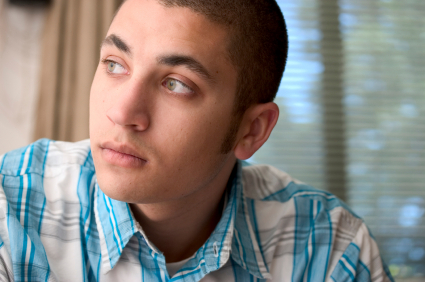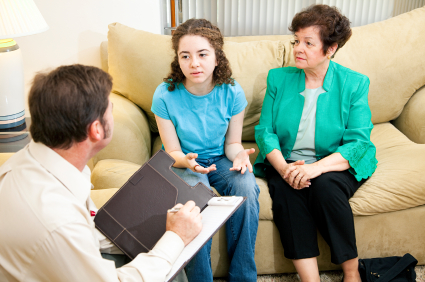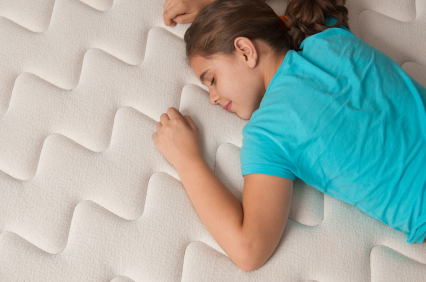Cognitive Deficits in Bipolar Children
At a symposium on new research on juvenile bipolar disorder at the meeting of the American Academy of Child and Adolescent Psychiatry (AACAP) in 2010, Ronna Fried from Massachusetts General Hospital reviewed executive function deficits that occur in children with bipolar disorder. These include difficulties in planning, working memory, response inhibition, emotional control, initiative, self-regulation, and the ability to shift focus when required.
Fried and her research group found that comorbid ADHD occurred in 69% of bipolar I children compared with 16% of controls. (ADHD involves many of the same executive function difficulties that occur in bipolar disorder—poor attention and difficulties with learning and memory.) Executive function deficits were observed in 45% of bipolar I patients compared with 17% of controls. Children with bipolar disorder who had executive function deficits had lower IQs, more difficulty reading, lower social functioning, decreased occupational functioning on long-term followup, and overall poor outcome of their illness.
Editor’s Note: These data emphasize the importance of cognitive remediation techniques in those who have major executive function deficits. Dr. Fried emphasized that rehabilitation works, and indicated its use is important for these children in order to moderate the otherwise more severe course of illness they may experience compared with those without executive function deficits.
Cortex Shrinks and Amygdala Grows in Childhood Bipolar Disorder
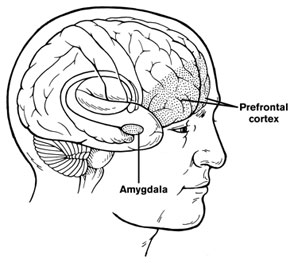 At a symposium on new research on juvenile bipolar disorder at the meeting of the American Academy of Child and Adolescent Psychiatry (AACAP) in 2010, the discussant Kiki Chang of Stanford University reported some recent neurobiological findings on childhood bipolar disorder. He found evidence that prefrontal cortical volume appears to decrease over the course of the illness and, conversely, there was evidence of increases in amygdala volume. He also found that the volume of the striatum (or caudate nucleus, which is involved in motor control) increased in children with bipolar illness or bipolar illness comorbid with ADHD, but decreased in children with ADHD alone.
At a symposium on new research on juvenile bipolar disorder at the meeting of the American Academy of Child and Adolescent Psychiatry (AACAP) in 2010, the discussant Kiki Chang of Stanford University reported some recent neurobiological findings on childhood bipolar disorder. He found evidence that prefrontal cortical volume appears to decrease over the course of the illness and, conversely, there was evidence of increases in amygdala volume. He also found that the volume of the striatum (or caudate nucleus, which is involved in motor control) increased in children with bipolar illness or bipolar illness comorbid with ADHD, but decreased in children with ADHD alone.
Chang cited the study of Singh et al. (2010) who found that the subgenual anterior cingulate volume early in the course of illness was smaller in adolescent-onset bipolar disorder compared to controls. Given this evidence of prefrontal cortical and anterior cingulate deficits, Dr. Chang raised the possibility that treatment with lithium and other agents with potential neurotrophic and neuroprotective effects might be able to prevent these neurobiological aspects of illness progression in young patients.
BP-NOS Often Develops Into Bipolar I or II Disorder
At a symposium on new research on juvenile bipolar disorder at the meeting of the American Academy of Child and Adolescent Psychiatry (AACAP) in 2010, David Axelson of the University of Pittsburgh summarized the longitudinal course of sub-syndromal bipolar disorder in children and adolescents as observed in a research program called COBY (Course and Outcome of Bipolar Youth). Axelson called attention to the 35% of the bipolar spectrum children who had a diagnosis of bipolar NOS (not otherwise specified) as opposed to the 58% who had full-blown bipolar I illness. BP-NOS is defined as illness not meeting criteria for bipolar I or II, including duration of illness and number of symptoms, so it includes presentations in which there is one fewer symptom present than the four required for a diagnosis of euphoric mania or the five required for a diagnosis of irritable mania. The mania or hypomania in BP-NOS must occur for at least four hours/day for at least four days.
Overall, the COBY researchers found that among children with a BP-NOS diagnosis, it was the duration of the manic symptoms that tended to fall short of the requirements for a BP-I or BP-II diagnosis rather than any qualitative difference in clinical presentation. The COBY study followed 446 BP-NOS patients aged 7 to 17 for an average of five years using the LIFE methodology, which rates severity of ill states on a weekly basis. The assessments of LIFE data were conducted at an average of eight-month intervals.
Axelson’s key point was that within the 5-year period of the study, 45% of the children with BP-NOS, which some would consider a subthreshold bipolar disorder, converted to a full-blown bipolar disorder; 23% to a BP-I presentation and 22% to a BP-II presentation. If there was a positive family history of mania, it was even more likely that a child with BP-NOS would convert to BP-I or BP-II (58.5%, as opposed to 35.5% when there was no positive family history for mania).
Children with BP-NOS are almost as highly impaired as those with BP-I and BP-II illness, and clearly deserve early treatment intervention, both to alleviate problematic symptomatology, but also to possibly prevent the conversion to more full-blown BP-I and II syndromes. Axelson stressed the importance of treating those with BP-NOS who do not convert to BP I or II, because they too remain substantially impaired.
Bipolar Disorder in Children Continues into Adulthood, Early Intervention Important
At a symposium on new research on juvenile bipolar disorder at the meeting of the American Academy of Child and Adolescent Psychiatry (AACAP) in 2010, researchers shared new findings about juvenile bipolar disorder. One was Kathleen Merikangas’ finding published in AACAP’s journal in 2010 that the incidence of Bipolar I and II disorders is substantial in the child population (2.6%), and most children with the illness are severely impaired. This estimate of the incidence of bipolar disorder in children approaches the 3.0% incidence of the disorder in adults.
Another finding came from Janet Wozniak of Massachusetts General Hospital. Wozniak followed children with a bipolar diagnosis longitudinally and found substantial evidence of impairment and continuity of the diagnosis over 2-3 years. She found that 73.1% of the original 78 children (aged 10.5 years at first evaluation) were still fully symptomatic with a BP-I diagnosis after 3.6 years of follow up. Only five children of the 78 achieved a euthymic status without treatment. Nine children became euthymic while on treatment, while 5 experienced subthreshold major depressive disorder and another six had subthreshold manic symptomatology.
Dr. Wozniak indicated that these data were similar to Barbara Geller’s eight-year followup study, in which patients remained symptomatic for two-thirds of the weeks of followup and 44.4% continued to show full-blown manic episodes. Researchers Barbara Geller, David Axelson, and Joe Biedermann all have found that while there is a high incidence of initial improvement or transient remission in childhood bipolar disorder, there is an equally substantial relapse rate, indicating that the considerable morbidity of childhood-onset bipolar illness continues into adolescence and young adulthood. Read more
N-acetylcysteine Improved the Irritability Associated with Autism
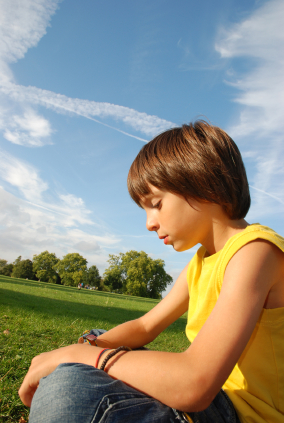 At the 57th Annual Meeting of the American Academy of Child and Adolescent Psychiatry (AACAP) in October 2010, Lawrence Fung of Stanford University reported that N-acetylcysteine (NAC), a compound sold over-the-counter in health food stores, improved irritability and other symptoms of autism in children aged 8 to 17. In this double-blind, randomized study of NAC compared with placebo, the children who received NAC were treated with 900mg once a day for four weeks, then 900mg BID (twice a day) for four weeks, and finally 900mg TID (three times a day) for the last four weeks of this three-month study. These doses significantly improved irritability and stereotypy (repetitive behaviors) compared with placebo. Side effects were minimal.
At the 57th Annual Meeting of the American Academy of Child and Adolescent Psychiatry (AACAP) in October 2010, Lawrence Fung of Stanford University reported that N-acetylcysteine (NAC), a compound sold over-the-counter in health food stores, improved irritability and other symptoms of autism in children aged 8 to 17. In this double-blind, randomized study of NAC compared with placebo, the children who received NAC were treated with 900mg once a day for four weeks, then 900mg BID (twice a day) for four weeks, and finally 900mg TID (three times a day) for the last four weeks of this three-month study. These doses significantly improved irritability and stereotypy (repetitive behaviors) compared with placebo. Side effects were minimal.
Editor’s note: The potential for a safe compound such as N-acetylcysteine to show efficacy in autism is striking. Currently only risperidone and aripiprazole are FDA-approved for effectiveness treating irritability in autism. There has also been a positive study of valproate compared with placebo in autism, although it is not FDA-approved for this purpose.
Most double-blind, placebo controlled clinical trials of NAC have been in adults, so this is the first report that suggests NAC can safely be used in children.
NAC’s ability to improve irritability in autism raises the possibility that this drug may be useful in the treatment of irritability and repetitive behaviors in bipolar disorder, particularly since N-acetylcysteine has also been reported to improve mood, especially depression, in adults with bipolar disorder in the studies of Mike Berk and colleagues published in Biological Psychiatry in 2008.
This study adds to the evidence that suggests N-acetylcysteine may reset the brain’s habit system in the ventral striatum (also called the nucleus accumbens), which is involved in the assessment of the reward value of a variety of substances of abuse and behaviors (as described in BNN Volume 14, Issue 1 from 2010). NAC improves a number of habit-related syndromes including cocaine, heroin, and gambling addictions, trichotillomania (compulsive hair-pulling), and now the irritability and stereotypic behaviors of autism.
In light of NAC’s profile of efficacy and safety, systematic exploration of the drug in childhood-onset bipolar illness is indicated. We are aware of at least one group that is planning such a study.
Guanfacine Augments Stimulants in ADHD
Tim Wilens of Massachusetts General Hospital presented a poster at the 57th Annual Meeting of the American Academy of Child and Adolescent Psychiatry (AACAP) in October 2010 that showed that extended release guanfacine could augment incomplete responses to stimulants in children with attention deficit hyperactivity disorder (ADHD). This double-blind, placebo-controlled study of children aged 6-17 used guanfacine doses of 4mg/day or less. Those children who received guanfacine in addition to the psychomotor stimulant they were already taking were more likely to improve and more likely to reach a satisfactory remission than those taking a placebo in addition to their regular psychomotor stimulant. These results suggest that adding an alpha 2 noradrenergic agonist compound like guanfacine to a psychomotor stimulant may bring about a more complete response in ADHD.
A Suggested Dosing Regimen for Lithium in Children
At the 57th Annual Meeting of the American Academy of Child and Adolescent Psychiatry (AACAP) in October 2010, Bob Findling of Case Western Reserve University reported finding a 58% response rate to lithium in children with bipolar I disorder. He explored three different dosing regimens, and recommends starting children off with 300mg capsules TID (three times a day) for a total of 900 mg/day, and then increasing by a single 300mg capsule every week until there is a good effect or until side effects emerge. The most typical side effects that he saw were headache, nausea, and vomiting.
Starting at a relatively high initial dose of 900mg/day is consistent with the finding that even high doses of lithium are absorbed and transferred into the brain quite slowly. This loading approach appears to be an excellent strategy for rapidly achieving the blood levels necessary for optimal therapeutics in young children. Findling also suggests that an upper limit of blood levels as high as 1.4 mEq/l is acceptable in children because, in his experience, children often appear to need higher doses and blood levels than do adults.
Quetiapine (Seroquel) May Be Effective in Childhood Mania
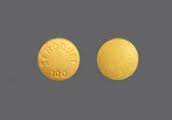 Gagan Joshi performed an 8-week open study of quetiapine in 30 preschool children and 19 school-age children. The mean dose was 176 mg/day on average for the preschool children, and 248 mg/day for the school age children, and both appeared highly effective in treating manic symptomatology. At the 57th Annual Meeting of the American Academy of Child and Adolescent Psychiatry (AACAP) in October 2010, Joshi reported that while the drug was generally well tolerated, it was associated with significant weight gain; the preschoolers gained 3.1 lbs on average in the 8-week period, while the school age children gained an average of 7.4 lbs.
Gagan Joshi performed an 8-week open study of quetiapine in 30 preschool children and 19 school-age children. The mean dose was 176 mg/day on average for the preschool children, and 248 mg/day for the school age children, and both appeared highly effective in treating manic symptomatology. At the 57th Annual Meeting of the American Academy of Child and Adolescent Psychiatry (AACAP) in October 2010, Joshi reported that while the drug was generally well tolerated, it was associated with significant weight gain; the preschoolers gained 3.1 lbs on average in the 8-week period, while the school age children gained an average of 7.4 lbs.
Activity Monitoring Discriminates Between BP Kids and ADHD Kids
At the 57th Annual Meeting of the American Academy of Child and Adolescent Psychiatry (AACAP) in October 2010, Gianni Faedda of the Lucio Bini Mood Disorders Center reported that monitoring of activity, sleep, and circadian-rhythm disturbances can be used to distinguish children with a diagnosis of bipolar illness (who showed more hyperactivity and less sleep), from children with ADHD and control children without illness.
Thyroid Abnormalities Common in Childhood Mental Illness
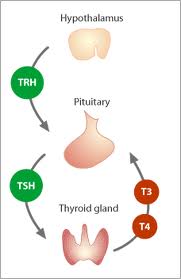 At the 57th Annual Meeting of the American Academy of Child and Adolescent Psychiatry (AACAP) in October 2010, Maria Gariup of Barcelona, Spain reported that thyroid abnormalities are common among children with major psychiatric diagnoses and, in particular, high levels of thyroid stimulating hormone (TSH) are common among those with bipolar illness.
At the 57th Annual Meeting of the American Academy of Child and Adolescent Psychiatry (AACAP) in October 2010, Maria Gariup of Barcelona, Spain reported that thyroid abnormalities are common among children with major psychiatric diagnoses and, in particular, high levels of thyroid stimulating hormone (TSH) are common among those with bipolar illness.
Editor’s Note: These findings may relate to reports of a greater incidence of anti-thyroid antibodies in adult patients with bipolar disorder compared with many other psychiatric groups.


